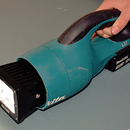Introduction: Drill to Buff Conversion
I needed a small bench mounted sander and buff to make some small projects. I noticed that you can get lot of attachments for drills so I mounted a drill to the bench. This is so easy that Im a bit embarrassed to write an instuctable about it as I thought that someone must of done this before. But looking through the instuctable site I couldn't find anyone who has mounted a drill like this, anyway,
I like really simple solutions to problems, and it doesn't get much simpler than this.
Step 1: Stuff You Will Need
1. A drill
2. Threaded rod they call it "all thread in some places"
3. Buffing and sanding attachments
4. Bench
5. Nylock nut
6. Hacksaw
7. ruler or tape
8. about 5 minutes
Step 2: Choose Your Drill
If you are buying a drill for this project, It needs to have an adjustable handle that is held together with a long bolt. Some drills have a different system and are not going to be as easy to mount on a bench. Also a keyless chuck will be good as you could hurt yourself on the teeth of a keyed chuck, and no chuck key to lose. Speed control is also good, as some of my project are plastic and resin I need to run the buff or sander at a lower speed to prevent the material from getting to hot and leaving marks. The best speed control have a dial and the trigger can be locked at any speed like the photo of the blue drill.
Step 3: Measure the Bolt
I just remove the bolt from the handle and measured its length and also the thickness of the bench i wanted to mount it to, just add those two measurements together. I got 5 inches, so made a note of that and now check the type of thread. If your not sure most Chinese stuff is metric most likely 8 mm. If you hold the bolt and the threaded rod together and the treads mesh like in the photo it is the right pitch. The threaded rod has to screw into the handle.
Step 4: Cut the Rod
Next I cut a five inch length of threaded rod and filed off the sharp bits, fitted the nylock nut to one end and put it back where the the bolt was fitted to the drill handle.
Step 5: Drill a Hole
Now I just drilled an 8mm hole in the bench and fitted the handle to the bench. Of course the drill can be removed quickly for storage or for drilling holes. In "buff mode" the drill can be rotated on the bench for awkwardly shaped projects or if it easier to use pointed in a different direction. Just make sure before you drill, that the hole will be in a position that the black on part of the handle can be screwed on.
Step 6: Speed Control
The cheap drill I bought has a cheap speed control, the speed increases the more you squeeze the trigger and the trigger lock will only work when the drill is going at full speed. This required a cheap solution, so a cable tie pulls the trigger on at about half speed. I turn the drill on an off at the wall socket.
There are lots of different attachments that will fit in a drill, my favourite is the flat disc that you can put automotive double sided tape on and then you stick a round project to the disc and sand and polish it.
Now I can make some of those fantastic jewellery projects that Mrballeng makes
https://www.instructables.com/member/Mrballeng/













